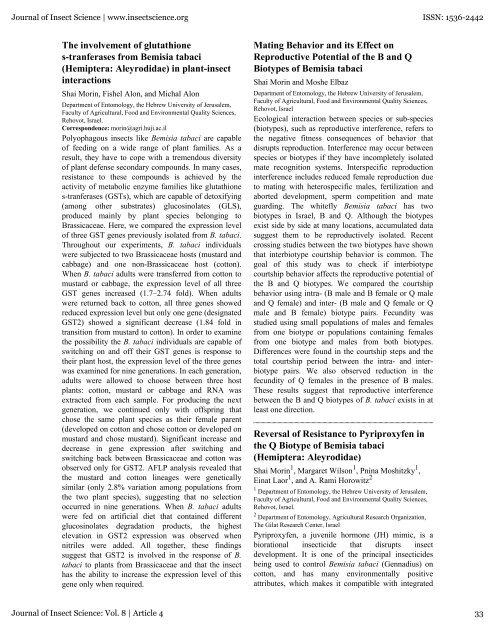Fourth International Bemisia Workshop International Whitefly ...
Fourth International Bemisia Workshop International Whitefly ...
Fourth International Bemisia Workshop International Whitefly ...
Create successful ePaper yourself
Turn your PDF publications into a flip-book with our unique Google optimized e-Paper software.
Journal of Insect Science | www.insectscience.org ISSN: 1536-2442<br />
The involvement of glutathione<br />
s-tranferases from <strong>Bemisia</strong> tabaci<br />
(Hemiptera: Aleyrodidae) in plant-insect<br />
interactions<br />
Shai Morin, Fishel Alon, and Michal Alon<br />
Department of Entomology, the Hebrew University of Jerusalem,<br />
Faculty of Agricultural, Food and Environmental Quality Sciences,<br />
Rehovot, Israel.<br />
Correspondence: morin@agri.huji.ac.il<br />
Polyophagous insects like <strong>Bemisia</strong> tabaci are capable<br />
of feeding on a wide range of plant families. As a<br />
result, they have to cope with a tremendous diversity<br />
of plant defense secondary compounds. In many cases,<br />
resistance to these compounds is achieved by the<br />
activity of metabolic enzyme families like glutathione<br />
s-tranferases (GSTs), which are capable of detoxifying<br />
(among other substrates) glucosinolates (GLS),<br />
produced mainly by plant species belonging to<br />
Brassicaceae. Here, we compared the expression level<br />
of three GST genes previously isolated from B. tabaci.<br />
Throughout our experiments, B. tabaci individuals<br />
were subjected to two Brassicaceae hosts (mustard and<br />
cabbage) and one non-Brassicaceae host (cotton).<br />
When B. tabaci adults were transferred from cotton to<br />
mustard or cabbage, the expression level of all three<br />
GST genes increased (1.7–2.74 fold). When adults<br />
were returned back to cotton, all three genes showed<br />
reduced expression level but only one gene (designated<br />
GST2) showed a significant decrease (1.84 fold in<br />
transition from mustard to cotton). In order to examine<br />
the possibility the B. tabaci individuals are capable of<br />
switching on and off their GST genes is response to<br />
their plant host, the expression level of the three genes<br />
was examined for nine generations. In each generation,<br />
adults were allowed to choose between three host<br />
plants: cotton, mustard or cabbage and RNA was<br />
extracted from each sample. For producing the next<br />
generation, we continued only with offspring that<br />
chose the same plant species as their female parent<br />
(developed on cotton and chose cotton or developed on<br />
mustard and chose mustard). Significant increase and<br />
decrease in gene expression after switching and<br />
switching back between Brassicaceae and cotton was<br />
observed only for GST2. AFLP analysis revealed that<br />
the mustard and cotton lineages were genetically<br />
similar (only 2.8% variation among populations from<br />
the two plant species), suggesting that no selection<br />
occurred in nine generations. When B. tabaci adults<br />
were fed on artificial diet that contained different<br />
glucosinolates degradation products, the highest<br />
elevation in GST2 expression was observed when<br />
nitriles were added. All together, these findings<br />
suggest that GST2 is involved in the response of B.<br />
tabaci to plants from Brassicaceae and that the insect<br />
has the ability to increase the expression level of this<br />
gene only when required.<br />
Mating Behavior and its Effect on<br />
Reproductive Potential of the B and Q<br />
Biotypes of <strong>Bemisia</strong> tabaci<br />
Shai Morin and Moshe Elbaz<br />
Department of Entomology, the Hebrew University of Jerusalem,<br />
Faculty of Agricultural, Food and Environmental Quality Sciences,<br />
Rehovot, Israel<br />
Ecological interaction between species or sub-species<br />
(biotypes), such as reproductive interference, refers to<br />
the negative fitness consequences of behavior that<br />
disrupts reproduction. Interference may occur between<br />
species or biotypes if they have incompletely isolated<br />
mate recognition systems. Interspecific reproduction<br />
interference includes reduced female reproduction due<br />
to mating with heterospecific males, fertilization and<br />
aborted development, sperm competition and mate<br />
guarding. The whitefly <strong>Bemisia</strong> tabaci has two<br />
biotypes in Israel, B and Q. Although the biotypes<br />
exist side by side at many locations, accumulated data<br />
suggest them to be reproductively isolated. Recent<br />
crossing studies between the two biotypes have shown<br />
that interbiotype courtship behavior is common. The<br />
goal of this study was to check if interbiotype<br />
courtship behavior affects the reproductive potential of<br />
the B and Q biotypes. We compared the courtship<br />
behavior using intra- (B male and B female or Q male<br />
and Q female) and inter- (B male and Q female or Q<br />
male and B female) biotype pairs. Fecundity was<br />
studied using small populations of males and females<br />
from one biotype or populations containing females<br />
from one biotype and males from both biotypes.<br />
Differences were found in the courtship steps and the<br />
total courtship period between the intra- and interbiotype<br />
pairs. We also observed reduction in the<br />
fecundity of Q females in the presence of B males.<br />
These results suggest that reproductive interference<br />
between the B and Q biotypes of B. tabaci exists in at<br />
least one direction.<br />
Reversal of Resistance to Pyriproxyfen in<br />
the Q Biotype of <strong>Bemisia</strong> tabaci<br />
(Hemiptera: Aleyrodidae)<br />
Shai Morin 1 , Margaret Wilson 1 , Pnina Moshitzky 1 ,<br />
Einat Laor 1 , and A. Rami Horowitz 2<br />
1 Department of Entomology, the Hebrew University of Jerusalem,<br />
Faculty of Agricultural, Food and Environmental Quality Sciences,<br />
Rehovot, Israel.<br />
2 Department of Entomology, Agricultural Research Organization,<br />
The Gilat Research Center, Israel<br />
Pyriproxyfen, a juvenile hormone (JH) mimic, is a<br />
biorational insecticide that disrupts insect<br />
development. It is one of the principal insecticides<br />
being used to control <strong>Bemisia</strong> tabaci (Gennadius) on<br />
cotton, and has many environmentally positive<br />
attributes, which makes it compatible with integrated<br />
Journal of Insect Science: Vol. 8 | Article 4 33
















